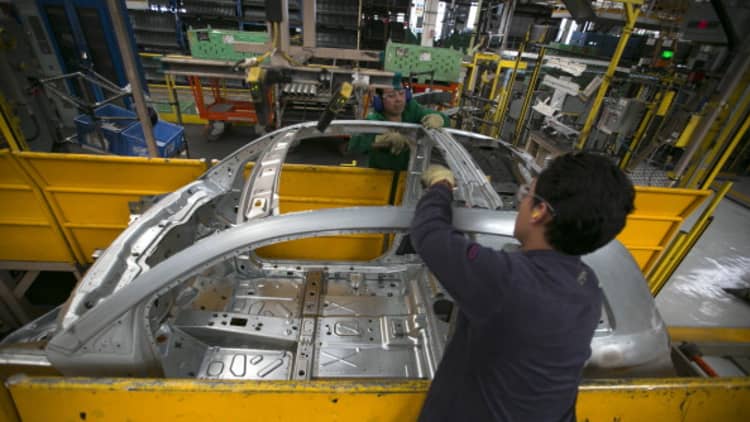The stock market rallied to new records this week on the prospects of a U.S.-Mexico trade deal, but the global trade war is far from over. A report on Thursday afternoon indicated that Trump is moving closer to his next round of tariffs against China on up to $200 billion in goods, and the Dow Jones Industrial Average dropped after the headline from Bloomberg. If the president finally follows through on this previously threatened move, it is a good time to review what investors already have learned about the trade war in 2018, and how it can still hit blue-chip stocks hard, especially with issues between the U.S. and China far from resolved.
China is still the biggest swing factor, and its stock market has been pummeled this year, officially entering a bear market with losses over 20 percent. Some segments of the U.S. market have held up well this year due to their domestic focus — small-cap stocks, which have easily beat the and Dow Jones Industrial Average, and health-care stocks, which are third best this year among S&P 500 sectors, behind only tech and consumer discretionary (which includes both Amazon and Netflix in its top 10 holdings). The broader market resilience as China has nosedived is notable.
The last time the Chinese market took a major leg down, between 2015 and 2016 — mainland Chinese stocks lost 30 percent of their value between June-July 2015 alone — the effects were felt in U.S. stocks. The wobbles in China's stock market threaten to disrupt that nation's growth and its ability to buy U.S. exports and it hit a lot of blue chips, and not just the industrials you would expect to suffer — starting with Apple.
Companies say tariffs have hurt profits, or will soon
Most major U.S. companies are now fully globalized, moving either finished goods or parts around the globe in search of the most cost-effective ways to do business. In second-quarter earnings reports, the market saw signs of how trade battles and rising import tariffs, in the U.S. and elsewhere, can change that. More than 40 companies said tariffs either have hurt their profits or soon will. Only seven said they helped. And that is before many measures the market fears the most are in place, like duties on cell phones imported from China, which are, by far, the largest cause of the U.S. trade deficit with that country.
While the United States has put tariffs on just $100 billion worth of goods so far this year — a small amount, considering the country imports $2.5 trillion of goods every year — if Trump continues to impose tariffs on China and Canada — some of the widely held names in the stock market remain exposed to a big potential hit. The head of a major European bank said Wednesday that the U.S. trade war with China is only now beginning to hit its corporate clients.
Even while the trade deal struck on Monday between Mexico and the United States alleviates some fears, U.S. tariffs on Mexico are still in place. And as much as another $200 billion in tariffs against China are still being weighed by the White House for implementation later this year. Meanwhile, the situation with Canada remains in flux, as its Prime Minister Justin Trudeau said Wednesday a NAFTA deal could be reached by Friday, but only if it is "a good deal for Canada."
1. Tech has led the market higher, but Apple is still at risk
Apple took one of the largest hits in the market when China's markets wobbled in 2015 into 2016, with shares losing a quarter of their value as uncertainty about Chinese consumption curbed Asian demand for iPhones. But Apple became the first U.S. company to reach a $1 trillion valuation in spite of the Chinese stock dive and the unresolved trade war with China.
The broader market has been effectively insulated from trade concerns because so much of the S&P 500 is tied up in tech stocks that have little exposure to the trade war, said CFRA Research strategist Lindsey Bell said. Out of the S&P's big five of Apple, Amazon.com, Microsoft, Facebook and Alphabet, all but Apple derive most of their market value from selling services, rather than goods that might get slapped with import taxes. Goldman Sachs recently said about two-thirds of Amazon's stock price represents its cloud-computing business. Facebook's record-setting post-earnings drop had nothing to do with tariffs.
I think [Trump] will try to avoid hurting the company directly. It's probably the most important U.S.-based [manufacturer] on the planet.Angelo ZinoCFRA analyst
It is Apple among those tech giants that stands to lose the most if the trade conflict with China gets worse.
"The ones you have to keep an eye on are those manufacturing in China and selling in America," Bell said. "There has been a positive impact early on for some, because orders are being pulled forward to avoid tariffs. What happens once we get past that is the question.''
Apple gets 21 percent of its sales in Greater China, and does final assembly for most phones there. An estimated $15.7 billion of the U.S.-China merchandise trade deficit last year came from iPhones, according to a Reuters analysis in January.
So far, cell phones have been exempt from Trump's move to pressure China on trade, partly because of CEO Tim Cook's personal lobbying, CFRA analyst Angelo Zino said. It would take a big move from Trump to put Apple at trade risk.
"I don't want to say anyone is immune, but if anyone has Trump's ear right now it's Tim Cook,'' Zino said. "I think [Trump] will try to avoid hurting the company directly. It's probably the most important U.S.-based [manufacturer] on the planet.''
Apple year-to-date return: 31 percent
2. Alcoa is in the heart of Trump's base, but Canada is key to its pricing
As the U.S. and Mexico worked out a trade deal it left Canada in the tough spot of being left out entirely. Canadian trade officials "rushed" to the U.S., according to press reports this week, once the Mexico news was out, to try and hammer out a deal.
Canada looms large for aluminum maker Alcoa, whose Pittsburgh headquarters is in the heart of the western-Pennsylvania through Minnesota belt of Midwestern states where Trump did better than expected in the 2016 election, but where management has said the president's "fair trade" policies are hurting business.
"One new and recurring unfavorable impact is tariffs on our imports into the U.S. mostly from our Canadian smelters," Alcoa CEO Roy Harvey said after second-quarter earnings were released. "Starting in June at $15 million, in the month, we expect a $12 million to $14 million negative monthly impact as long as tariffs are in place. … for our Canadian production, we will either pay tariffs on metal we import into the U.S. or we will sell it outside the U.S. at a lower premium."
Its shares have not had a good year.
Alcoa year-to-date return: (negative 16 percent)
3. Auto stocks got boost from Mexico deal, but Ford has a lot riding on China
The deal with Mexico should give GM a much clearer view of issues related to Mexican assembly and parts suppliers. U.S. automakers use Mexico for final assembly of predominantly lower-priced vehicles (with some exceptions), freeing more expensive U.S. labor to make cars and trucks that command wider profit margins.
But aluminum and steel tariffs are also a big issue for the car makers. Investors got their most pungent taste of trade war on July 24, when General Motors shares dropped 8.4 percent after a profit-forecast cut the company blamed on 25 percent tariffs on steel and aluminum the administration has already imposed. Along with fellow auto giant Ford, GM is among more than 45 companies that cited trade policy in profit reports all but seven of which said the policy hurt profits.

The Chinese trade war still looms as a headwind for Ford. Ford took a $300 million hit in the quarter on higher metal costs, and faces more impacts if tension with China escalates. Moody's Investor Service downgraded Ford debt to one notch above junk on Wednesday and cited its tenuous position in China — though not only related to the trade war — as a key reason for the elevated credit risk.
GM makes more cars with a Chinese joint venture, so GM executives expect fewer problems with China. Korea's Hyundai Motors has said tariffs battles over parts could raise costs of its Alabama-made vehicles by 10 percent.
Neither automaker has performed well this year, even though both rallied after the Mexico deal news.
GM year-to-date return: (negative 9 percent)
Ford year-to-date: (negative 20 percent)
4. Whirlpool is still a big victim of metals tariffs
Irony alert: One of the first companies Trump set out to protect, by slapping tariffs on Korean-made clothes washers and dryers in January, has turned out to be a victim of rising metals expenses.
Whirlpool rallied this week with the broader market, but is down big this year. Whirlpool said after its recent earnings that "input costs" would be $50 million to $100 million above forecasts, which was responsible for 18 percent of its big year-to-date stock dive
Earlier this year, the government reported that the price of laundry equipment had risen 17%, as the taxes on competitors provided a price floor for domestic manufacturers like Michigan-based Whirlpool.
Whirlpool year-to-date return: (negative 22 percent)
5. Asia remains the No. 1 swing factor for industrials like Deere, Caterpillar and United Tech
There has been a lot of concern about industrials and the trade war, but the sector as a whole has mostly been the dog that hasn't barked, says Jim Corridore, who follows the sector for CFRA. The sector has returned a little over 3 percent this year, which is well below the broader market, but shows it hasn't taken a huge hit amid all the trade war fears.
United Technologies actually raised its earnings guidance after reporting second-quarter results July 25. The $400 million in tariff-related expenses reported by General Electric aren't near the top of the list of GE's problems, Corridore said. The group "got a huge benefit from tax reform and has been buying back shares,'' Corridore said. "Tariffs are negative but manageable for most companies."
However, some of the most widely held industrial stocks have suffered. And the thing is, industrial companies are heavily dependent on exports to Asia, a fact that led Caterpillar to drop 27 percent in late 2015 and early 2016, Deere to fall 18 percent and United Tech to slip 25 percent, according to S&P Dow Jones Indices analyst Howard Silverblatt.
The key now is to watch capacity utilization and industrial production data for any signs of slowing demand from Asia, he said.
Caterpillar year-to-date return: (negative 10 percent)
Deere year-to-date return: (negative 7 percent)
United Technologies year-to-date return: 7 percent
GE year-to-date return: (negative 25 percent)




